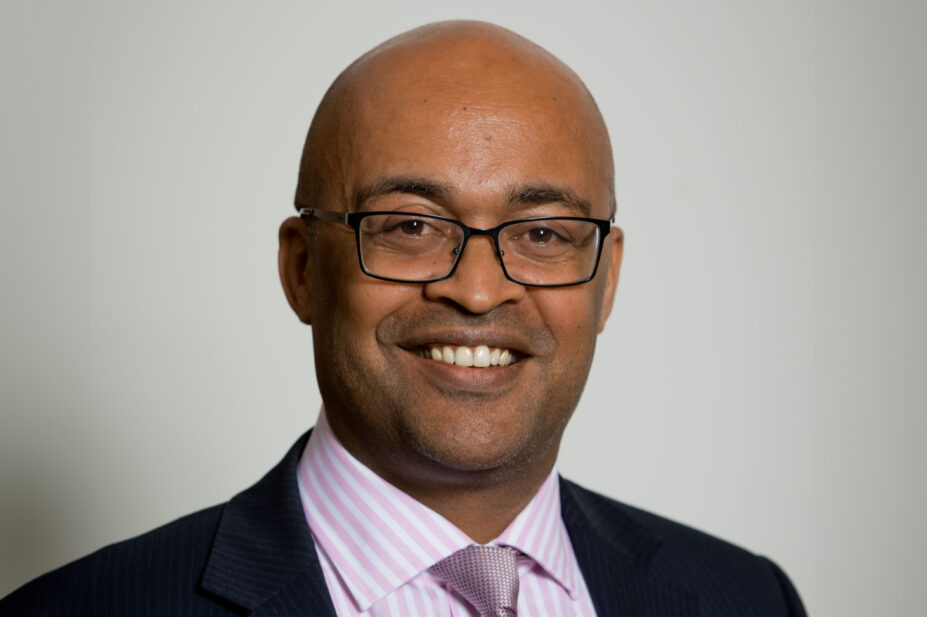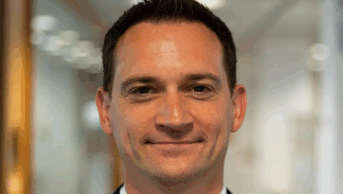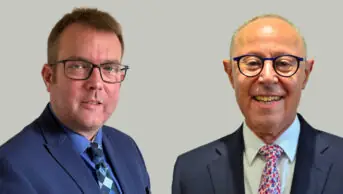
National Pharmacy Association
Since joining the National Pharmacy Association (NPA) as chief executive in November 2023, Paul Rees has been vocal in speaking out against community pharmacy closures.
Prior to his seven-year tenure as chief executive of the Royal College of Psychiatrists, Rees’ previous roles have included director of policy and engagement at the Royal College of GPs, director of communications at the Charities Aid Foundation and head of communications at the Home Office.
As the first black chief executive of a major national pharmacy organisation, Rees is passionate about promoting equality and diversity in the profession.
The Pharmaceutical Journal caught up with Rees to discuss Pharmacy First, workforce issues and the NPA’s ambition for community pharmacy funding.
What are your priorities as chief executive of the NPA over the next year?
The sector is at a crossroads; it’s in the midst of the worst funding crisis in living memory, because the percentage of the NHS budget given to community pharmacy has declined from 2.4% to 1.6% and funding in real terms has fallen by 40% in the past ten years.
There are eight pharmacies closing per week. [Around] 1,000 pharmacies have closed over the past ten years, while 72% are in deficit.
Lots of pharmacies are only still going because dedicated, committed independent pharmacists are putting money in from their own pockets and that obviously causes a great deal of distress.
The number of pharmacies is crumbling and we’ve got to address this now
No one really knows if the margin system is working. Nobody knows when they’re buying medication, whether there might be a clawback in a few months’ or even a year’s time.
I think the role of the NPA right now is to be there to support community pharmacists at this difficult time and be the voice of community pharmacy.
What needs to happen to address pharmacy closures?
In 2023, there was a record number of 394 closures. If that level is sustained, by the end of 2025 we’d be under 10,000 pharmacies in England for the first time since 2006. The number of pharmacies is crumbling and we’ve got to address this now.
In community pharmacy, you’ve got this recognition of the role pharmacists can play, the additional clinical services that can be delivered and the pressure they can take off general practice. Yet at the same time, funding in real terms continues to decline.
Without increased funding, the closures will continue. The closures happen disproportionately in poorer areas where people tend to be even more reliant on the local pharmacy than people in other areas.
It’s not just about the services that are recorded. There are lots of services that are unrecorded, such as helping people with social care issues, helping point people to go to A&E and helping point people to go to the right service. A lot of these things are not actually reported, so pharmacists are not being paid for the huge role they play in the community.
If you’re in deficit and you’re delivering the service, you’re working six days a week, the amount of pressure you’re under is unimaginable.
There’s a moral duty for the NHS and the government to stand behind community pharmacies, the whole team and the community pharmacist. It’s something that needs to happen now. This is an urgent crisis that is unfolding right before us.
What is the NPA calling for to improve the situation?
We believe that the government needs to commit to ensuring that 2.5% of the NHS budget is given to community pharmacy, which will see it being adequately resourced in terms of the margin element of the global sum and there should be a moratorium on clawbacks.
The funding model is broken. There is a £1.3m funding black hole. We need a new deal for pharmacy and that should be based on dispensing, on fees for clinical services, deprescribing and social prescribing.
The new deal must also include inflation linked year-on-year increases so that pharmacy funding is not based on how hard we can squeeze pharmacists, but how we can support them to deliver a great service to the public.
If you look at the way money has flowed in the past ten years, across the system it’s undulated, ebbed and flowed.
Funding for general practice has increased over the past ten years in real terms by about 20% and at the same time, funding for community pharmacy over the same period has fallen.
Could the proposals in the government’s consultation on pharmacy supervision help address pharmacy workforce issues?
Absolutely. We believe that the whole pharmacy team should be respected for being the experts they are. There’s a greater role that the whole team can play and we believe that if a pharmacist has authorised the pharmacy technician to be the person signing off the dispensing of medicines and the pharmacist leaves the site for two hours, that is absolutely appropriate, because pharmacy technicians also are experts.
Over the years, pharmacists have not been respected for the clinical experts that they are. They’ve been asked to operate below their skill level and the same is the case for pharmacy technicians.
Pharmacy is having its moment in the sun in terms of the way policymakers view it. People are asking can the whole team do more? And the answer to that is yes.
We think the supervision consultation is potentially going to give us a good outcome and will assist community pharmacy.
The delivery of Pharmacy First is safe and will remain safe, but there is a human cost on pharmacists and the team
Is not having protected learning time for training affecting pharmacists’ ability to deliver Pharmacy First safely?
I’ve been struck by how Pharmacy First is already going great guns.
Community pharmacists are such dedicated clinicians that, of course, the delivery of Pharmacy First is safe and will remain safe, but there is a human cost on pharmacists and the team.
One of the challenges is an unfairness in the way that pharmacists are treated by the NHS and by the government.
GPs, who also are contractors, are seen as giving clinical value, so the system thinks how can we support general practice? How can we give them protected learning time? It’s totally unfair.
Dedicated pharmacists, who already are working harder than other clinicians, are having to do their learning, mostly in the evening or on a Sunday on their one day of rest, because they don’t get paid time to learn, unlike many other clinicians. That leads to massive pressure on individuals.
The NHS and the government should be helping to support community pharmacy and recognise that we’re talking about human beings who are at the sharp end of the NHS.
Should the Pharmacy First service be expanded?
What’s interesting is that the Pharmacy First initiatives in each of the four nations are all different. We would like policymakers from across the UK to come together to hold a summit looking at what’s working best to make sure that we can adopt the best bits from each of the four nations.
In Northern Ireland when new conditions were added, it was in a slow and steady fashion. There wasn’t a big bang.
It’s important that as we get Pharmacy First embedded in England, we need to ensure that when other conditions are added, it is done in a careful and managed way, so that pharmacists have a chance to take on board the new requirements.
Then pharmacy can deliver expanded services that will take away pressure from general practice. General practice is on its knees. We all know how hard it is to get an appointment to see your GP and lots of GPs say privately that Pharmacy First could be the saviour of general practice.
A properly supported community pharmacy sector will work really well alongside general practice. Together, we can have an excellent primary care sector, but it requires proper support and resourcing from the government and the NHS.
By making botulinum toxin and dermal filler insurance available for community pharmacies, is the NPA encouraging them to diversify the services they offer?
Because pharmacists are so dedicated and passionate, they carry out a number of services for free, such as doing home deliveries or making up some blister packs, which are not funded. They are also delivering and dispensing medication through an NHS funding model that is broken.
We’re encouraging pharmacists to look at new business models and diversifying what they do by delivering more clinical services. Inevitably some of them will be private services, because this is a sector that is in crisis.
What needs to happen to address medicine shortages?
Another challenge from the lack of resourcing and the penny-pinching attitude we’ve had is the medicine supply issue.
Medicine supply challenges are worse in the UK than many other comparator nations because we’ve been trying to squeeze money out of the system and pharmacists are on the sharp end of that.
We want a properly resourced system so that patients can access medicines and advice in a way that is properly thought out and planned.
We’re hopeful that the COVID-19 inquiry could play a part here, because the NPA is a core participant in two of the modules.
During the pandemic, when other services closed, the public went to get clinical services from their community pharmacies.
We hope that when the COVID-19 inquiry reaches its conclusions, one of the recommendations will be that the community pharmacy sector is properly resourced, so that it’s standing in a good place and is sustainable if there is another pandemic. The only way we can achieve that is by ensuring that the never-ending spiral of real terms cuts ends.
How is the NPA promoting diversity and inclusion?
We’ve got a rapidly changing board with six new board members. I’m really proud of the diversity on that board. Nine out of the 15 board members are of Asian heritage.
I’m the first black chief executive of the NPA and the first black chief executive of any major national committee pharmacy representative body.
In community pharmacy, a large percentage of people in the workforce are women and a large percentage of community pharmacy owners are of south Asian background. It’s important for the NPA, as the representative body for independent pharmacies, that we celebrate that diversity, and we make sure that all members feel as though they belong and are part of the NPA.
We want to ensure that people, whatever their background and characteristics, have the chance to fulfil their ambitions.
Has the NPA heard any updates on when the hub-and-spoke model might be implemented?
Hub-and-spoke dispensing is something that several multiples are using. A few years ago, it was seen as being something that potentially could have a panacea effect, but from what we’re seeing now, it’s not. It’s a model that is part of the mix of community pharmacy, but it’s not a silver bullet.
You may also be interested in

Henry Gregg: ‘The only way to slow down pharmacy closures is to start closing that £2.6bn funding gap’

Dale and Appelbe’s Pharmacy and Medicines Law: covering ‘essential ground in the most highly regulated areas of healthcare’
